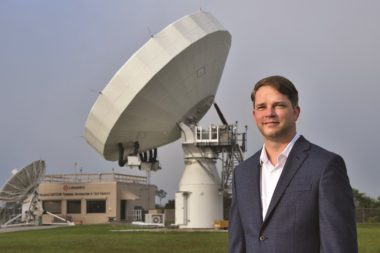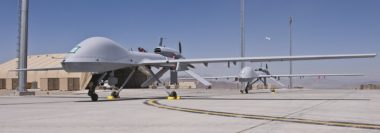Don Claussen is passionate about satellite communications. After serving for seven years in the U.S. Army on active duty, Claussen worked as a systems engineer working for the Army Communications-Electronics Research, Development and Engineering Center (CERDEC) Space and Terrestrial Communications Directorate, helping soldiers deploy very small aperture terminals in Iraq and Afghanistan following the Sept. 11, 2001 terrorist attacks.

Now as vice president and general manager for Army and Homeland Defense programs for L3Harris Technologies Broadband Communications Systems Sector, Claussen is helping to integrate the satellite communications (SATCOM) products of L3 Technologies with those of Harris Corp. in the wake of the June merger.
Claussen recently spoke with SpaceNews correspondent Debra Werner about the merger and the evolution of military satellite constellations.
SN : What’s L3Harris’ role in satellite communications? Does it produce airborne, ship-based and ground-based antennas and terminals?
Yes. All the above. We have stationary ground terminals that go from 0.65 meters to over 12 meters, on-the-move antennas for ground vehicles such as the Soldier Network Extension in the Warfighter Information Network-Tactical program, airborne terminals such as the one on the Army’s Grey Eagle Unmanned Aerial Vehicle and shipboard terminals. We provide 1.3-meter and 2.7-meter terminals for the U.S. Navy’s Commercial Broadband Satellite program.
What does the L3Harris Technologies merger mean for satellite communications?
I think we already have best-in-breed products but they’re going to be even better from the combined organization. Whereas legacy L3 had some gaps in our protective SATCOM offerings, Harris made them up and vice versa. In the end, I think the industry as a whole is going to see a really strong team coming out of this merger overall and specifically for SATCOM. I’m very excited about it.
Are there specific examples of Harris filling in gaps in L3’s product line?
I can’t go into much detail because of classification but there is an anti-jam, anti-scintillation waveform that has been used in some applications for years. We had a good offering for time division multiple access demand-assigned multiple access on the Protected Tactical Waveform program. The waveform in that mode from the Harris side filled a gap in that for gateway communications.
How does your previous job with CERDEC inform your current work?
At the CERDEC, I supported the Program Executive Office for Command, Control and Communications from late 2001 to mid2006. Then, from 2009 to 2011, I supported that organization as a contracted systems engineer. I was part of a team of SATCOM subject matter experts that designed and deployed very small aperture terminals for use in Iraq and Afghanistan. The terminals that we deployed had 2.4-meter antennas and associated networking and voice equipment. We architected the systems, and then trained soldiers to operate the equipment, including acquiring the satellite. Most of the soldiers we trained were not in communications-related jobs. They were mechanics, logisticians and administrative personnel. We were pushing SATCOM down to levels where those assets weren’t originally intended to be.
The years I spent with the soldiers operating in a deployed environment informs all of my current work. As we would return to perform upgrades and follow-on training, we learned how the soldiers were using their equipment and the challenges they faced operating and maintaining the system.

Is it now easier for soldiers to operate the equipment?
From a terminal perspective, SATCOM technology has advanced exponentially. One of our divisions, Global Communications Solutions, has small, fully integrated terminals. All you do is push a button and it will find a spacecraft for you. Now, instead of having a whole bunch of wires and a whole bunch of things to put together, you have a handful of things to put together.
How are antennas and terminals evolving?
I believe we are going to move from mechanically-steered apertures to electronically steerable antenna technology that becomes conformal over time.
Will those help the U.S. military?
Electronically steerable antenna technology will most likely have an impact on the adoption rate of low Earth orbit services by the Defense Department. The tracking capabilities, beam forming and shaping capabilities go beyond what mechanical tracking antennas can do.
Conformal antennas are attractive because they can blend in with a vehicle. Think of electric cars now on the road with solar panels built into their roofs. You can imagine how industry should be looking at doing similar things with conformal antenna technology.
Electronically steerable antenna technology and conformal antennas can also provide the ability to locate antennas on various surfaces, not just on the top of platforms, and provide varying levels of service instead of allor-nothing connections.
Can technology help satellite operator’s address concerns of interference or jamming?
One of the first problems that needs to be solved is identification when interference or jamming is present. Next, you have to be able to do something about it, and to notify the right people.
There are several technologies that L3Harris has developed that address interference and jamming, including technologies to automatically sense these events and take corrective action. It can be as simple as excising interference, or more complex, such as enabling countermeasures to mitigate the threat. We are helping operators by detecting, mitigating and reporting in a way that doesn’t create an additional burden on the end user.

Can the U.S. military take advantage of new low and medium Earth orbit constellations?
Absolutely. Commercial entities with a lot of money behind them want to be disruptive and want to work with the government. They will offer higher data rates, lower latency and large coverage areas. We will have to overcome some obstacles along the way. Terminals will need the ability to roam between networks, and the low Earth orbit constellations will need to be stitched into DoD networks.
Does that raise security concerns?
Yes. A lot of these new networks are going to be private. The government is going to buy a service. So it doesn’t necessarily control the security parameters. Companies like L3Harris create devices that provide data encryption. We’ll continue to build those into our networks and government,working with industry, can push those requirements onto commercial networks so that we’re comfortable using them.
Anything else you want to say?
Think about our cellphones. We roam between networks. We go in and out of Wi-Fi coverage and it doesn’t affect us. How do we give soldiers and sailors and airmen communications devices with similar access to the data they need? That’s where we are moving because we will have so many options.
This article originally appeared in the Sept. 2, 2019 issue of SpaceNews magazine.
#Space | https://sciencespies.com/space/in-wake-of-merger-l3harris-technologies-seeks-expanded-role-in-an-evolving-satcom-market/
No comments:
Post a Comment